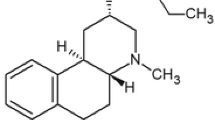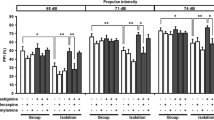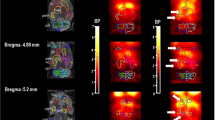Abstract
The paw test was used to detect the preclinical profile (classical versus atypical) of five putative, atypical neuroleptics, namely olanzapine, sertindole, risperidone, prothipendyl and ORG 5222. In the paw test classical neuroleptics increase the hindlimb reaction time (HRT), a parameter with predictive validity for antipsychotic efficacy, at doses comparable to those necessary for increasing forelimb reaction time (FRT), a parameter with predictive validity for extrapyramidal side-effects, whereas atypical neuroleptics increase HRT at doses that are much smaller than those increasing FRT. All tested compounds showed the profile of atypical neuroleptics in the paw test. Using the FRT/HRT ratio of minimum effective doses as overall predictor of a favourable ratio of extrapyramidal and therapeutic effects of these drugs, the following order was found: olanzapine (20) > sertindole = risperidone = prothipendyl (10) > ORG 5222 (3). The ability of compounds to attenuate locomotor activity elicited either from the olfactory tubercle (10 µg dopamine: OT test) or from the nucleus accumbens (1 µg ergometrine: ACC test) was used to establish whether the compounds preferentially act in one of these structures. Previous research has shown that classical neuroleptics are far less potent in the OT test than in the ACC test, whereas atypical neuroleptics are far more potent in the OT test than in the ACC test. All five agents preferentially acted in the olfactory tubercle. The order of potency in the olfactory tubercle was as follows: sertindole > ORG 5222 > risperidone > olanzapine > prothipendyl. It is concluded that risperidone, prothipendyl, ORG 5222, sertindole and olanzapine not only show the profile of atypical neuroleptics in the paw test, but also preferentially act in the olfactory tubercle, but not in the nucleus accumbens, viz. two features that they share with the atypical neuroleptics clozapine and thioridazine and with the putative, atypical neuroleptics raclopride and remoxipride.
Similar content being viewed by others
References
Alder S, Candrian R, Elsner J, Zbinden G (1986) Neurobehavioral screening in rats: validation study. Methods Findings Exp Clin Pharmacol 8:279–289
Awouters, F, Niemegeers CJE, Megens AAHP, Meert TF, Janssen PAJ (1988) Pharmacological profile of ritanserin: a very specific central serotonin S2 antagonist. Drug Dev Res 15:61–73
Bluth R, Langnickel R (1985) Effects of haloperidol and low doses of clozapine on the acetylcholine turnover in rat forebrain structures. Biomed Biochim Acta 44:1531–1539
Borison RL, Diamond BI, Pathiraja A, Meibach RC (1992a) Clinical overview of risperidone. In: Meltzer HY (ed) Novel antipsychotic drugs. Raven Press, New York, pp 233–239
Borison RL, Pathiraja AP, Bruche I, Diamond BI, Meibach RC (1992b) Risperidone: clinical safety and efficacy in schizophrenia. Psychopharmacol Bull 28:213–218
Bressa GM, Bersani G, Meco G, Bouciqué E, Pozzi F (1991) One year follow-up study with risperidone in chronic schizophrenia. New Trends Exp Clin Psychiatry 4:169–177
Broekkamp CLE, De Graaf JS, van Delft AML (1990) Behavioural pharmacology of trans-5-chloro-2-methyl-2,3,3a,12b-tetrahydro-1H-dibenz[2,3:6,7]oxepino[4,5-c]pyrrolidine maleate, a compound interacting with dopaminergic and serotonergic receptors. Drug Res 40:544–549
Brownstein M, Saavedra JM, Palkovits (1974) Norepinephrine and dopamine in the limbic system of the rat. Brain Res 79:431–436
Chiodo LA (1988) Dopamine-containing neurons in the mammalian central nervous system: electrophysiology and pharmacology. Neurosci Biobehav Rev 12:49–91
Chouinard G, Arnott W (1993) Clinical review of risperidone. Can J Psychiatry 38, [Suppl. 3]:S89-S95
Chouinard G, Jones B, Remington G, Bloom D, Addington D, McEwan GW, Labelle A, Beauclair L, Arnott W (1993) A Canadian multicenter placebo-controlled study of fixed doses of risperidone and haloperidol in the treatment of chronic schizophrenic patients. J Cli Psychopharmacol 13:25–40
Clarke PBS, Jakubovic A, Fibiger HC (1988) Anatomical analysis of the involvement of mesolimbocortical dopamine in the locomotor stimulant actions ofd-amphetamine and apomorphine. Psychopharmacology 96:511–520
Claus A, Bollen J, De Cuyper H, Eneman M, Malfroid M, Peuskens J, Heylen S (1991) Risperidone versus haloperidol in the treatment of chronic schizophrenic inpatients: a multicenter double-blind comparative study. Acta Psychiatr Scand 85:295–305
Cools AR (1986) Mesolimbic dopamine and its control of locomotor activity in rats: differences in pharmacology and light/dark periodicity between the olfactory tubercle and the nucleus accumbens. Psychopharmacology 88:451–459
Cools AR (1989) Similarities and dissimilarities between the pharmacology of dopamine-dependent behaviour elicited from distinct mesolimbic structures. Behav Pharmacol 1 [Suppl 1]:8
Cools AR, Van Rossum JM (1976) Excitation-mediating and inhibition-mediating dopamine receptors: a new concept towards a better understanding of electrophysiological, biochemical, functional and clinical data. Psychopharmacology 45:243–254
Cools AR, Prinssen E, Ellenbroek BA (1992) Interaction between aminergic systems in mesolimbic structures: the importance of 5-HT2, D2 and D1 receptors in the olfactory tubercle for the atypical profile of neuroleptics. Clinical Neuropharmacol 15 [Suppl 1]:618a-619a
Cools AR, Prinssen EPM, Ellenbroek BA, Heeren D (1994) Role of olfactory tubercle and nucleus accumbens in the effects of classical and atypical neuroleptics: search for regional specificity. In: Palomo T, Archer T, Beninger RJ (eds) Strategies for studying brain disorders, vol. 2: Schizophrenia, movement disorders and age related cognitive disorders. Editorial Complutence and London Farrand Press, Madrid, pp 33–53
Costall B, Naylor RJ (1976) A comparison of the abilities of typical neuroleptic agents and of thioridazine, clozapine, sulpiride and metoclopramide to antagonize the hyperactivity induced by dopamine applied intracerebrally to areas of the extrapyramidal and mesolimbic systems. Eur J Pharmacol 40:9–19
Danner H, Pfister C, Morgenstern R (1982) Beitrag zur Transmitterhistochemie des Tuberculum olfactorium der Ratte. J Hirnforsch 23:394–397
De Boer Th, Tonnaer JADM, De Vos CJ, Van Delft AML (1990) Neurochemical studies with the potential antipsychotic compound trans-5-chloro-2-methyl-2,3,3a,12b-tetrahydro-1H-di-benz{2,3,:6,7}oxepino[4,5-c]pyrrolidine maleate. Drug Res 40:550–554
Deutch AY, Moghaddam B, Innis RB, Krystal JH, Aghajanian GK, Bunney BS, Charney DS (1991) Mechanisms of action of atypical antipsychotic drugs: implications for novel therapeutic strategies for schizophrenia. Schizophr Res 4:121–156
Ellenbroek BA (1988) Thesis: animal models for schizophrenia and neuroleptic drug action. Krips Repro, Meppel
Ellenbroek BA (1993) The treatment of schizophrenia: a clinical and preclinical evaluation of neuroleptic drugs. Pharmacol Ther 57:1–78
Ellenbroek BA, Cools AR (1988) The paw test: an animal model for neuroleptic drugs which fulfils the criteria for pharmacological isomorphism. Life Sci 42:1205–1213
Ellenbroek BA, Peeters BW, Honig WM, Cools AR (1987) The paw test: a behavioural paradigm for differentiating between classical and atypical neuroleptic drugs. Psychopharmacology 93:343–348
Ellenbroek BA, Prinssen EPM, Cools AR (1992) The azaphenothiazine prothipendyl is an atypical neuroleptic acting through dopamine D1 and D2 receptors. Neurosci Res Commun 11:155–161
Ellenbroek BA, Prinssen EPM, Cools AR (1994) The role of serotonin receptor subtypes in the behavioural effects of neuroleptic drugs. A paw test study in rats. Eur J Neurosci 6:1–8
Fallon JH, Loughlin SE, Ribak CE (1983) The islands of Calleja complex of rat basal forebrain. III. Histochemical evidence for a striatopallidal system. J Comp Neurol 218:91–120
Gilad GM, Reis DJ (1979) Transneuronal effects of olfactory bulb removal on choline acetyltransferase and glutamic acid decarboxylase activities in the olfactory tubercle. Brain Res 178:185–190
Guevara-Aguilar R, Solano-Flores LP, Donatto-Alberran OA, Aguilar-Baturoni (1982) Differential projections from locus coeruleus to olfactory bulb and olfactory tubercle. Brain Res Bull 8:711–719
Harrison DA, Satterlee W, Tran P, Beasley CM, Tollefson GD (1994) Olanzapine: a potential ‘atypical’ antipsychotic agent — phase II clinical findings. Schizophr Res 11:107
Hoyberg OJ, Fensbo C, Remvig J, Lingjaerde O, Sloth-Nielsen M, Salvesen I (1993) Risperidone versus perphenazine in the treatment of chronic schizophrenic patients with acute exacerbations. Acta Psychiatr Scand 88:395–402
Hyttel J, Nielsen JB, Nowak G (1992) The acute effect of sertindole on brain 5-HT2, D2 and α1 receptors (ex vivo radioreceptor binding sites). J Neural Transm 89:61–69
Janssen PAJ, Niemegeers CJE, Schellekens KHL (1965) Is it possible to predict the clinical effects of neuroleptic drugs (major tranquillizers) from animal data? Drug Res 15:56–69
Janssen PAJ, Niemegeers CJE, Awouters F, Schellekens KHL, Megens AAHP, Meert TF (1988) Pharmacology of risperidone (R 64 766), a new antipsychotic with serotonin-S2 and dopamine-D2 antagonistic properties. J Pharmacol Exp Ther 244:685–693
Köhler C, Hall H, Magnusson O, Lewander T, Gustafsson K (1990) Biochemical pharmacology of the atypical neuroleptic remoxipride. Acta Psychiatr Scand 82 [Suppl 358]:27–36
König JFR, Klippel RA (1963) The rat brain. William and Wilkins, Baltimore
Leysen JE, Gommeren W, Eens A, De Chaffoy de Courcelles D, Stoof JC, Janssen PAJ (1988) Biochemical profile of risperidone, a new antipsychotic. J Pharmacol Exp Ther 247:661–670
Leysen JE, Janssen PMF, Schotte A, Luyten WHML, Megens AAHP (1993) Interaction of antipsychotic drugs with neurotransmitter receptor sites in vitro and in vivo in relation to pharmacological and clinical effects: role of 5HT2 receptors. Psychopharmacology 112:S40-S54
Lingham RB, Gottesfeld Z (1986) Deafferentiation elicits increased dopamine-sensitive adenylate cyclase and receptor binding in the olfactory tubercle. J Neurosci 6:2208–2214
Martin PT, Grebb JA, Schmitz PJ, Sebree TB, Kashkin KB (1994) Efficacy and safety of sertindole in double-blind, placebo-controlled trials of schizophrenic patients. Schizophr Res 11:107
McEvoy J, Borrison R, Small J, Van Kammen D, Meltzer H, Hamner M, Morris D, Shu V, Sebree T, Grebb J (1993) The efficacy and tolerability of sertindole in schizophrenic patients: a pilot, double-blind, placebo-controlled, dose-ranging study. Schizophr Research 9:244
McGeer PL, Kimura H, McGeer EG, Peng JH (1982) Cholinergic systems in the CNS. In: Bradford HF (ed) Neurotransmitter interactions and Compartmentation. Plenum Press, New York, pp 253–289
Meert TF, Awouters F (1991) Serotonin 5HT2 antagonists: a preclinical evaluation of possible therapeutic effects. In: Idzikowski C, Cowen PJ (eds) Serotonin, sleep and mental disorders. Wrightson Biomedical Publishing pp 65–76
Meert TF, Janssen PAJ (1989) Psychopharmacology of ritanserin: comparison with chlordiazepoxide. Drug Dev Res 18:119–144
Meltzer HY (1992) The importance of serotonin-dopamine interactions in the action of clozapine. Br J Psychiatry 160 [Suppl 17]:22–29
Moore NA, Tye NC, Axton MS, Risius FC (1992) The behavioral pharmacology of olanzapine, a novel “atypical” antpsychotic agent. J Pharmacol Exp Ther 262:545–551
Moore NA, Calligaro DO, Wong DT, Bymaster F, Tye NC (1993) The pharmacology of olanzapine and other new antipsychotic agents. Curr Opin Invest Drugs 2:281–293
Moore NA, Rees G, Sanger A, Tye NC (1994) Effects of olanzapine and other antipsychotic agents on responding maintained by a conflict schedule. Behav Pharmacol 5:196–202
Parent A, Descarries L, Beaudet A (1981) Organization of ascending serotonin systems in the adult rat brain. Neuroscience 6:115–138
Piazza PV, Calza L, Giardino L, Amato G (1990) Chronic thioridazine treatment differently affects DA receptors in striatum and in mesolimbo-cortical systems. Pharmacol Biochem Behav 35:937–942
Pijnenburg AJJ, Woodruff GN, Van Rossum JM (1973) Ergometrine induced locomotor activity following intracerebral injection into the nucleus accumbens. Brain Res 59:289–302
Pijnenburg AJJ, Honig WMM, Struyker Boudier HAJ, Cools AR, Van Der Heyden JAM, Van Rossum JM (1976a) Further investigations on the effects of ergometrine and other ergot derivatives following injection into the nucleus accumbens of the rat. Arch Int Pharmacodyn Thér 222:103–115
Pijnenburg AJJ, Honig WMM, Van Der Heyden JAM, Van Rossum, JM (1976b) Effects of chemical stimulation of the mesolimbic dopamine system upon locomotor activity. Eur J Pharmacol 35:45–58
Powell TPS, Cowan WM, Raisman G (1965) The central olfactory connections. J Anat 99:791–813
Remington GJ (1993) Clinical considerations in the use of risperidone. Can J Psychiatry 38:S96-S100
Rotter A, Birdsal NJM, Burgen ASV, Field PM, Hulme EC, Raisman G (1979) Muscarinic receptors of the central nervous system of the rat. Brain Research Reviews 1:141–165
Saavedra JM, Brownstein M, Palkovits M (1974) Serotonin distribution in the limbic system of the rat. Brain Res 79:437–441
Sanchez C, Arnt J, Dragsted N, Hyttel J, Lembol HL, Meier E, Perregaard J, Skarsfeldt T (1991) Neurochemical and in vivo pharmacological profile of sertindole, a limbic-selective neuroleptic compound. Drug Dev Res 22:239–250
Shute CCD, Lewis PR (1967) The ascending cholinergic reticular system: neocortical, olfactory and subcortical projections. Brain 9:497–520
Skarsfeldt T (1992) Electrophysiological profile of the new atypical neuroleptic, sertindole, on midbrain dopamine neurones in rats: acute and repeated treatment. Synapse 10:25–33
Stawarz RJ, Hill H, Robinson SE, Setler P, Dingell JV, Sulser F (1975) On the significance of the increase in homovanillic acid (HVA) caused by antipsychotic drugs in corpus striatum and limbic forebrain. Psychopharmacologia 43:125–120
Suarez-Roca B, Lovenberg T, Cubeddu, LX (1987) Comparative dopamine-cholinergic mechanisms in the olfactory tubercle and the striatum: effects of metoclopramide. J Pharmacol Exp Ther 243:840–851
Vrijmoed-de Vries MC (1991) Pilot clinical study with a new antipsychotic. Biol Psychiatry 29:678
Author information
Authors and Affiliations
Rights and permissions
About this article
Cite this article
Cools, A.R., Prinssen, E.P.M. & Ellenbroek, B.A. The olfactory tubercle as a site of action of neuroleptics with an atypical profile in the paw test: effect of risperidone, prothipendyl, ORG 5222, sertindole and olanzapine. Psychopharmacology 119, 428–439 (1995). https://doi.org/10.1007/BF02245859
Received:
Revised:
Issue Date:
DOI: https://doi.org/10.1007/BF02245859




